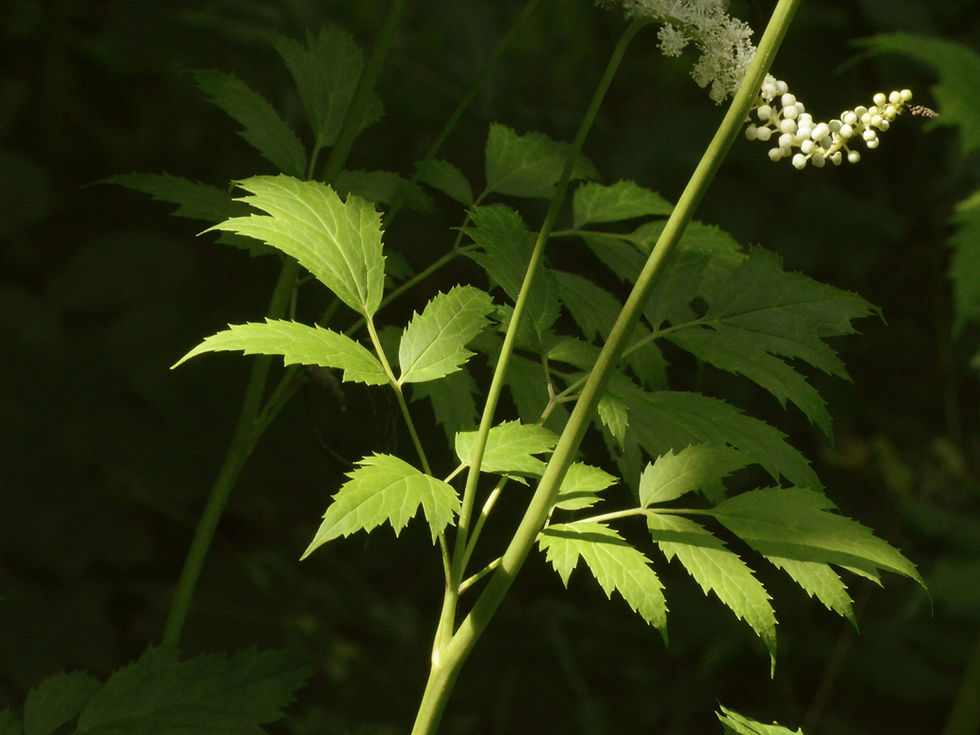Avoid These Herbs
- brwherbalist
- 2 days ago
- 4 min read
The scary story of at-risk medicinal plants.

Looking for a spooky story? There are medicinal plants that are over harvested to the point of being at-risk of extinction.
For this reason, there are a handful of plants in "critical condition" I NEVER work with in my practice of herbal medicine, and other "at-risk" plants that I work with with less often.
For the most part, a plant being at-risk has to do with how it grows and what conditions are required. Many medicinal plants grow like weeds, while others require unique growing conditions like high altitude or rare soil chemistry. One at-risk medicinal plant, Trillium, takes 7 years of growth to produce a seed! This is a much longer time frame from seed-to-seed that we are used to in cultivation.

Some plants purely dislike cultivated growing conditions, for example, Osha, and humans have been unsuccessful in our ability cultivate them in herb farms, requiring that they are taken from wild spaces for use. Which, I also ethically disagree with.
The way humans have, and continue to encroach on wild spaces often disrupts the well-being of plants and other species, and when there is a commercial market for certain medicinal plants, this puts pressure on the beautiful wild places, like The Appellation Mountains, home to at-risk plants like Black Cohosh and American Ginseng, where us two-leggeds have gone too far by putting these plants near the edge of extinction.
I do not, nor purchase from, or recommend ANYONE take from the wild, which is commonly called "wildcrafting." I believe we have taken enough from wild spaces and it is our duty as practitioners of herbal medicine to not exacerbate the imbalances of the world, but to recalibrate them.
Especially in the context of whiteness, where indigenous people have had their land taken from them, and every treaty broken. When people of color and indigenous communities suffer from chronic diseases at higher rates, and have lower life expectancies, in the name of justice and well-being for all, how can we ethically continue to take from the wild?

Which is a big reason why I grow medicine gardens and teach about medicinal plant cultivation. By learning to grow the plants and make our own medicine we are doing our part to lessen the market demand and encroachment on wild spaces. As a clinical herbalist there are a plethora of plants to choose from that grow abundantly, and I always reach for these first when working with clients.
There are ways as a consumer of herbs and herbal products you can do your part too:
Avoid using at-risk plants in tea, tincture or other herbal products. There is a non profit called United Plant Savers (UPS) which manages a list of plants that are known to be at-risk and in critical condition.
Take a few minutes to review this list, or perhaps print out their handy PDF download to post somewhere you can reference often. Before you buy a product, review the label and make sure the at-risk plants are not in the ingredients list. If they are, check to see if they are cultivated (not wildcrafted) and if they are not, do not buy the product. Consider a different product, and consider reaching out to the company using wild-crafted herbs to tell them you won't be supporting their brand.
I was recently reading a book on herbs for Menopause which suggested a formula with False Unicorn Root, which is known to be in critical condition according to UPS. I was turned-off by the author's choice, why not encourage readers to choose another herb that might work in a similar way?
If my point is not clear by now, PLEASE DO NOT USE ANY PLANT ON THE CRITICAL LIST, and make sure that ANY plant in a product from the UPS list has been cultivated on a farm and not taken from the wild.
All too often products and un-wise herbalists will advertise that something wildcrafted is somehow better or more potent. THIS IS NOT TRUE. There are known ways to grow bio-active, potent medicine and to simulate wild conditions and increase the medicinal value of cultivated plants and the extracts they produce.

So please, only buy cultivated plants. Or grow your own. Check the label, or ask your herbal sources if they wildcraft, and the next time you're on a walk and someone suggests harvesting from the wild ("It's free" or "There's so much" come to mind as excuses) just say, "How 'bout we learn to grow it ourselves" or "I don't want to reinforce colonialism by taking from indigenous land."
Many plant blessings to you and yours. If you enjoyed this post and want to join my herbal community, for weekly tips of holistic wellbeing, event announcements and more, check out my weekly newsletter, Whale Mail 🐋
























Comments